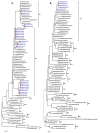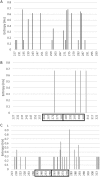Co-Circulation of 72bp Duplication Group A and 60bp Duplication Group B Respiratory Syncytial Virus (RSV) Strains in Riyadh, Saudi Arabia during 2014
- PMID: 27835664
- PMCID: PMC5106011
- DOI: 10.1371/journal.pone.0166145
Co-Circulation of 72bp Duplication Group A and 60bp Duplication Group B Respiratory Syncytial Virus (RSV) Strains in Riyadh, Saudi Arabia during 2014
Abstract
Respiratory syncytial virus (RSV) is an important viral pathogen of acute respiratory tract infection (ARI). Limited data are available on molecular epidemiology of RSV from Saudi Arabia. A total of 130 nasopharyngeal aspirates were collected from children less than 5 years of age with ARI symptoms attending the Emergency Department at King Khalid University Hospital and King Fahad Medical City, Riyadh, Saudi Arabia between October and December, 2014. RSV was identified in the 26% of the hospitalized children by reverse transcriptase PCR. Group A RSV (77%) predominated during the study as compared to group B RSV (23%). The phylogenetic analysis of 28 study strains clustered group A RSV in NA1 and ON1 genotypes and group B viruses in BA (BA9) genotype. Interestingly, 26% of the positive samples clustered in genotypes with duplication in the G protein gene (ON1 for group A and BA for group B). Both the genotypes showed enhanced O-linked glycosylation in the duplicated region, with 10 and 2 additional sites in ON1 and BA respectively. Selection pressure analysis revealed purifying selection in both the ON1 and BA genotypes. One codon each in the ON1 (position 274) and BA genotypes (position 219) were positively selected and had high entropy values indicating variations at these amino acid positions. This is the first report describing the presence of ON1 genotype and the first report on co-circulation of two different genotypes of RSV with duplication in the G protein gene from Saudi Arabia. The clinical implications of the simultaneous occurrence of genotypes with duplication in G protein gene in a given population especially in the concurrent infections should be investigated in future. Further, the ongoing surveillance of RSV in this region will reveal the evolutionary trajectory of these two genotypes with duplication in G protein gene from largest country in the Middle East.
Conflict of interest statement
The authors have declared that no competing interests exist.
Figures





Similar articles
-
Evolutionary analysis of the ON1 genotype of subtype a respiratory syncytial virus in Riyadh during 2008-16.Infect Genet Evol. 2020 Apr;79:104153. doi: 10.1016/j.meegid.2019.104153. Epub 2019 Dec 24. Infect Genet Evol. 2020. PMID: 31881360
-
Characteristics and Their Clinical Relevance of Respiratory Syncytial Virus Types and Genotypes Circulating in Northern Italy in Five Consecutive Winter Seasons.PLoS One. 2015 Jun 5;10(6):e0129369. doi: 10.1371/journal.pone.0129369. eCollection 2015. PLoS One. 2015. PMID: 26047100 Free PMC article.
-
The genetic variability of glycoproteins among respiratory syncytial virus subtype A in China between 2009 and 2013.Infect Genet Evol. 2014 Oct;27:339-47. doi: 10.1016/j.meegid.2014.07.030. Epub 2014 Aug 7. Infect Genet Evol. 2014. PMID: 25109878
-
Prevalence of human respiratory syncytial virus circulating in Iran.J Infect Public Health. 2016 Mar-Apr;9(2):125-35. doi: 10.1016/j.jiph.2015.05.005. Epub 2015 Jul 2. J Infect Public Health. 2016. PMID: 26143136 Review.
-
Molecular epidemiology of respiratory syncytial virus.Rev Med Virol. 2018 Mar;28(2). doi: 10.1002/rmv.1968. Epub 2018 Jan 29. Rev Med Virol. 2018. PMID: 29377415 Review.
Cited by
-
BA9 lineage of respiratory syncytial virus from across the globe and its evolutionary dynamics.PLoS One. 2018 Apr 25;13(4):e0193525. doi: 10.1371/journal.pone.0193525. eCollection 2018. PLoS One. 2018. PMID: 29694383 Free PMC article.
-
Molecular characterization of human respiratory syncytial virus in Seoul, South Korea, during 10 consecutive years, 2010-2019.PLoS One. 2023 Apr 6;18(4):e0283873. doi: 10.1371/journal.pone.0283873. eCollection 2023. PLoS One. 2023. PMID: 37023101 Free PMC article.
-
Diversity and evolution of computationally predicted T cell epitopes against human respiratory syncytial virus.PLoS Comput Biol. 2023 Jan 10;19(1):e1010360. doi: 10.1371/journal.pcbi.1010360. eCollection 2023 Jan. PLoS Comput Biol. 2023. PMID: 36626370 Free PMC article.
-
Dominance of the ON1 Genotype of RSV-A and BA9 Genotype of RSV-B in Respiratory Cases from Jeddah, Saudi Arabia.Genes (Basel). 2020 Nov 9;11(11):1323. doi: 10.3390/genes11111323. Genes (Basel). 2020. PMID: 33182267 Free PMC article.
-
Epidemiology of respiratory viruses in Saudi Arabia: toward a complete picture.Arch Virol. 2019 Aug;164(8):1981-1996. doi: 10.1007/s00705-019-04300-2. Epub 2019 May 28. Arch Virol. 2019. PMID: 31139937 Free PMC article. Review.
References
-
- Gimferrer L, Campins M, Codina MG, Martin Mdel C, Fuentes F, Esperalba J, et al. (2015) Molecular epidemiology and molecular characterization of respiratory syncytial viruses at a tertiary care university hospital in Catalonia (Spain) during the 2013–2014 season. J Clin Virol 66: 27–32. 10.1016/j.jcv.2015.02.018 - DOI - PubMed
-
- Esposito S, Piralla A, Zampiero A, Bianchini S, Di Pietro G, Scala A, et al. (2015) Characteristics and Their Clinical Relevance of Respiratory Syncytial Virus Types and Genotypes Circulating in Northern Italy in Five Consecutive Winter Seasons. PLOS ONE 10: e0129369 10.1371/journal.pone.0129369 - DOI - PMC - PubMed
MeSH terms
Substances
Grants and funding
LinkOut - more resources
Full Text Sources
Other Literature Sources
Medical

